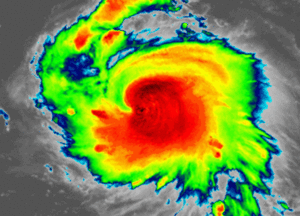Rapid intensification facts for kids
In meteorology, which is the study of weather, rapid intensification happens when a tropical cyclone (like a hurricane or typhoon) gets much stronger very quickly. The United States National Hurricane Center says this happens when a storm's maximum sustained winds increase by at least 30 knots (about 35 mph or 56 km/h) in just 24 hours.
Contents
What Makes a Storm Get Strong Fast?
For a tropical storm to get much stronger in a short time, several things need to be just right.
Outside Conditions Needed
- Warm Water: The ocean water must be super warm, around 30 degrees Celsius (86 degrees Fahrenheit) or even hotter. This warm water also needs to be deep enough. If it's not deep, big waves can stir up cooler water from below, which stops the storm from getting stronger.
- Low Wind Shear: Wind shear is when winds blow at different speeds or in different directions at different heights in the atmosphere. If wind shear is high, it can tear apart the storm's structure and stop it from growing. So, low wind shear is needed.
- Moist Air: Dry air can also stop a tropical cyclone from getting stronger. Storms need lots of moist air to fuel their growth.
Inside the Storm
- Upper-Level Anticyclone: Usually, a high-pressure system called an anticyclone needs to be above the storm, high up in the troposphere (the lowest part of Earth's atmosphere). This helps air flow away from the top of the storm.
- Rising Air: Air needs to rush towards the low pressure at the storm's center. This air then rises very fast in the storm's eyewall (the strong ring of thunderstorms around the calm eye).
- Air Divergence: As air rises, it needs to spread out and move away from the top of the storm. The upper-level anticyclone helps push this air away, making the storm more efficient at getting stronger.
- Hot Towers: Sometimes, very tall thunderstorms called hot towers form in the storm. These can be linked to rapid intensification, but their exact role can be different for various storms.
How We Measure Rapid Intensification
The United States National Hurricane Center used to define "rapid deepening" based on how much the storm's central pressure dropped. Now, they define rapid intensification by how much the storm's maximum winds increase. It's an increase of at least 30 knots (about 35 mph or 56 km/h) in 24 hours.
Newer studies suggest that the storm's pressure at sea level might be a better way to predict how much damage a hurricane will cause when it hits land.
Predicting Future Super Storms
Scientists are looking at how climate change might affect rapid intensification.
- Warmer Oceans: In the future, warmer ocean temperatures are expected to lead to more intense hurricanes, especially along the U.S. Atlantic coasts. This is partly due to the greenhouse effect.
- Gulf of Mexico: For the Gulf of Mexico coasts, forecasts suggest that there might be enough wind shear to somewhat reduce rapid storm intensification there.
- Recent Examples: In 2017, Hurricane Maria and Hurricane Harvey both got much stronger very quickly.
See also
 In Spanish: Rápida intensificación para niños
In Spanish: Rápida intensificación para niños
- Tropical cyclone
- List of the most intense tropical cyclones
- Explosive cyclogenesis
- Annular tropical cyclone


